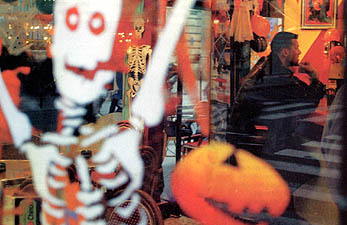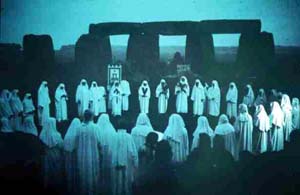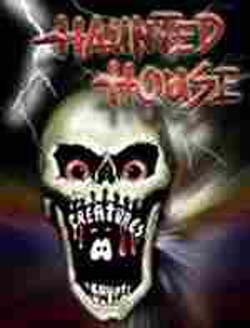 |
Faith under Attack
Halloween: A Return to Paganism
Marian T. Horvat, Ph.D.
Every year around this time, a challenge is raised by the sorcerers against the saints. It doesn’t take an astute mind to figure out which side is holding the upper ground these days.
Halloween skeletons, witches, ghosts, spiders and crows along with pumpkins decorate windows and lawns with almost the same regularity as Christmas lights and crèches. Adults and children discuss and prepare costumes for their cheery trick-or-treating and parties. Youths visit haunted houses; television networks sponsor monster feasts featuring every kind of horror show; real witches and warlocks give interviews explaining the significance and importance of their special holiday.

Restaurants and cafes decorate for the feast of Halloween. A return to paganism? |
Each year, at the same time, some Catholic churches, schools, and families bravely counter with festivals of Saints. Children dress up as their patron or favorite saints to celebrate All Saints Day, November 1, a solemn feast and holyday of obligation to honor all those – known and unknown – who already are in the glory of God. The next day, November 2, is All Souls Day, when Catholics pray for the relief of the souls suffering in Purgatory, especially their family members.
I can remember the Sisters of Charity instructing us to visit a Church to pray six Our Fathers, Hail Mary’s and Glory Be’s for the intentions of the Pope to receive a plenary indulgence for a soul in Purgatory. You could exit and re-enter the Church to offer the prayers for another soul. My mother would tell about the “holy contests” she and her friends had in the little town of St. Mary’s, KS, to see who could get the most souls out of Purgatory. In Mexico el dia de los muertos, the day of the dead, was a major holiday, with families making elaborate home altars where they offered special prayers for members who had died.
These good Catholic customs and practices have been largely forgotten and put aside with the increasing decline of Christianity and corresponding rise of Paganism. Even the holyday of obligation has been abrogated, and many Catholics no longer think of the religious significance of Halloween, which means a holy eve, from the Old English all hallow E'en. Unfortunately there is reason for that negligence. In the media and classrooms, all the attention is paid to pumpkins, monsters, blood and gore. In the Church, those holy customs of years past are ridiculed as pre-Vatican II anachronisms and priests no longer preach about Purgatory.
Pagan origins

The Celts adopted many Druid ceremonies and religious customs. Above, a mid-summer solstice ceremony carried out today |
Halloween’s origins date back to the ancient Celtic festival of Samhein which marked the end of harvest and the beginning of winter, a time of year associated with death. The pagan Celts believed that on that night, the boundary between the worlds of the living and dead blurred, and the ghosts of the dead returned to the earth. It was a night for preternatural communication with the dead, various forms of divination and prophecy, and sexual rituals.
By the 800s, the influence of the Catholic Church entered into Celtic lands. In the seventh century, Pope Boniface IV had already designated November 1 All Saints' Day, a time to honor saints and martyrs. Later, the Church would make November 2 All Souls' Day, a day to honor the dead. The eve of All Saints', All Saints', and All Souls were celebrated with big bonfires, parades, and dressing up in costumes as saints, angels, and devils.
This was the wise way the missionary Church acted in face of this pagan feast that she transformed. She ordered the customs and habits that existed among a people to the Catholic Religion.
A reverse process – the return to Paganism
How can we interpret the great emphasis today on the ghoulish and occult aspects of Halloween? Is it simply a process of secularization? A night to exploit the credulousness of children and their fears of spirits and ghosts? I think there is something more.
Instead of the Church wisely instituting sound traditions to replace the pagan customs, we are witnessing a reverse process today. A pagan society is wiping out the very memory of our Catholic feasts. Halloween, once used to designate the eve of the Feast of All Saints, has become a strictly secular holiday in the minds of most people. The Feast of All Souls is all but wiped out of the minds of society at large.

Haunted houses like the Creatures Crypt in Bloomington (IL) offer chills and thrills - the nervous excitement of paganism |
The Catholic feasts aimed to show that the just soul who believes in the Resurrection and an eternal reward need not fear death. It commemorates the dead and doing so, invites the faithful to make a healthful meditation on death. Exploiting the skeletons, ghosts, vampires and demons, even in the ludicrous form of costumes and masks, the modern Halloween does more than obliterate the memory of death – it is a kind of invitation for our children to be accustomed to the worst side of Paganism, which is its familiarity with horror and the devil.
The very fact that Catholics aren’t more disturbed over this rampant neo-paganism and the effacement of our religious feasts is a sign of how much Catholic vigilance has been weakened. Through the years most parents have stopped transmitting Catholic customs to children, the nuns and priests in Catholic schools no longer pass along the Catholic heritage and traditions. The result is generations of children without the memory of religious holidays and traditions.
What is taking their place? It is not just secular values and materialism. What we see is the return to the demoniac rituals of Paganism.
For example, today Halloween stresses aggression, the macabre, blood, death, monsters and even immoral figures. What horizons do these sinister and grotesque figures open up for children and youth? Not the marvelous, but the horrendous. What kind of emotions do they stimulate? Not the temperate and serene bereavement over death of Catholic celebrations, but the fear and nervous excitement of pagan rituals. The grotesque and monstrous are becoming co-natural to the modern spirit, a typical product of neo-paganism.
So what should we do about Halloween?
In principle, what is presented to a child should tend to make him more mature if it is healthy in its influence. The Church, in her wisdom, stimulated the festival of Saints, to form children by stimulating their imaginations as well as opening their horizons to the great and gallant deeds of the heroes and heroines of her History. She encouraged prayers and celebrations for the souls of the faithful departed so her children would be balanced and serene, instead of frenzied and fearful, in face of the specter of death.
In face of this, here is my advice: Avoid entering into the neo-pagan commemorations of Halloween. Reinstitute the Catholic customs and celebrate happy and holy All Saints and All Souls feast days.

Posted October 26, 2004
|
Faith under Attack | Religious | Home | Books | CDs | Search | Contact Us

© 2002-
Tradition in Action, Inc. All Rights Reserved
|
 |
|